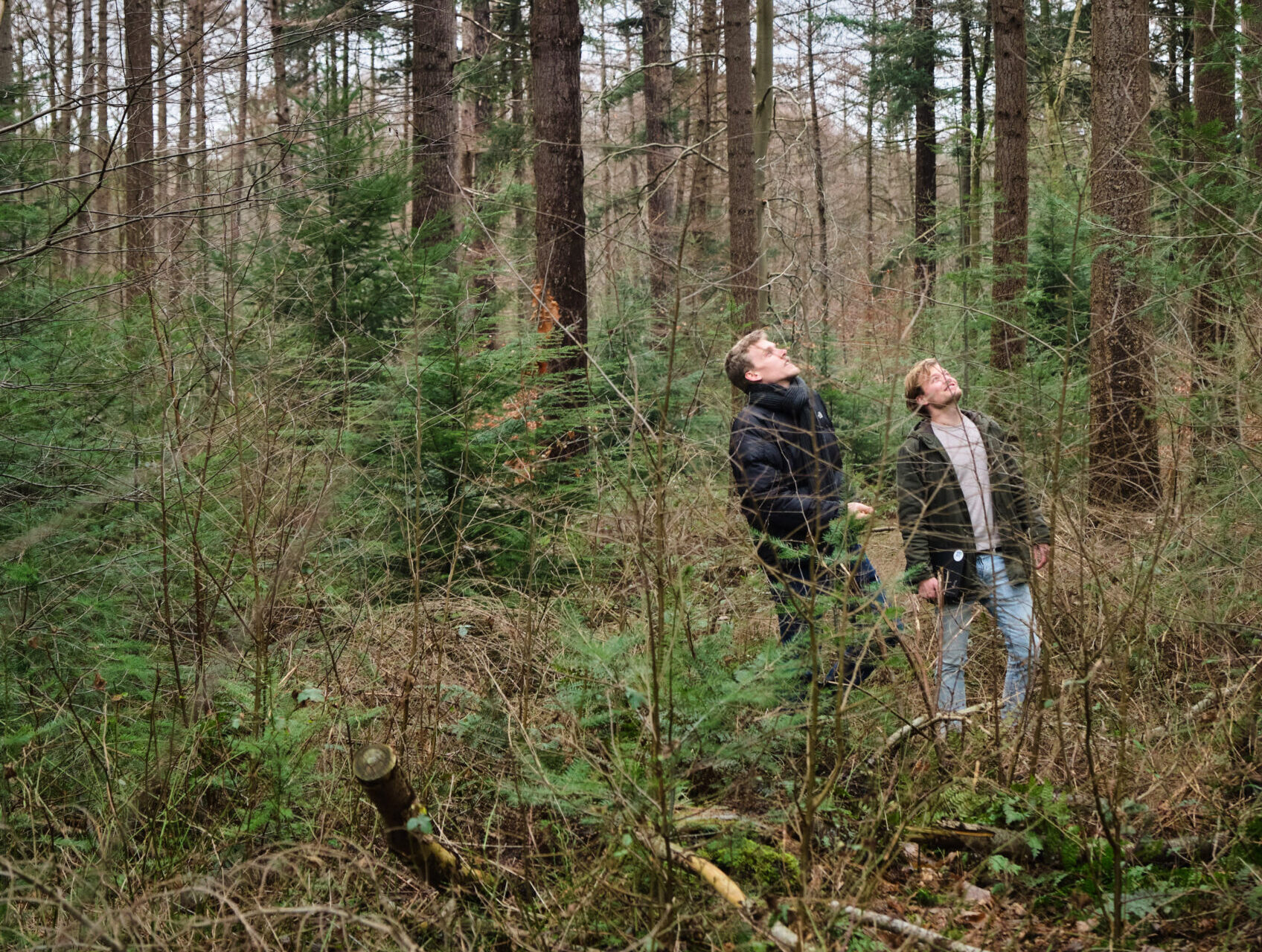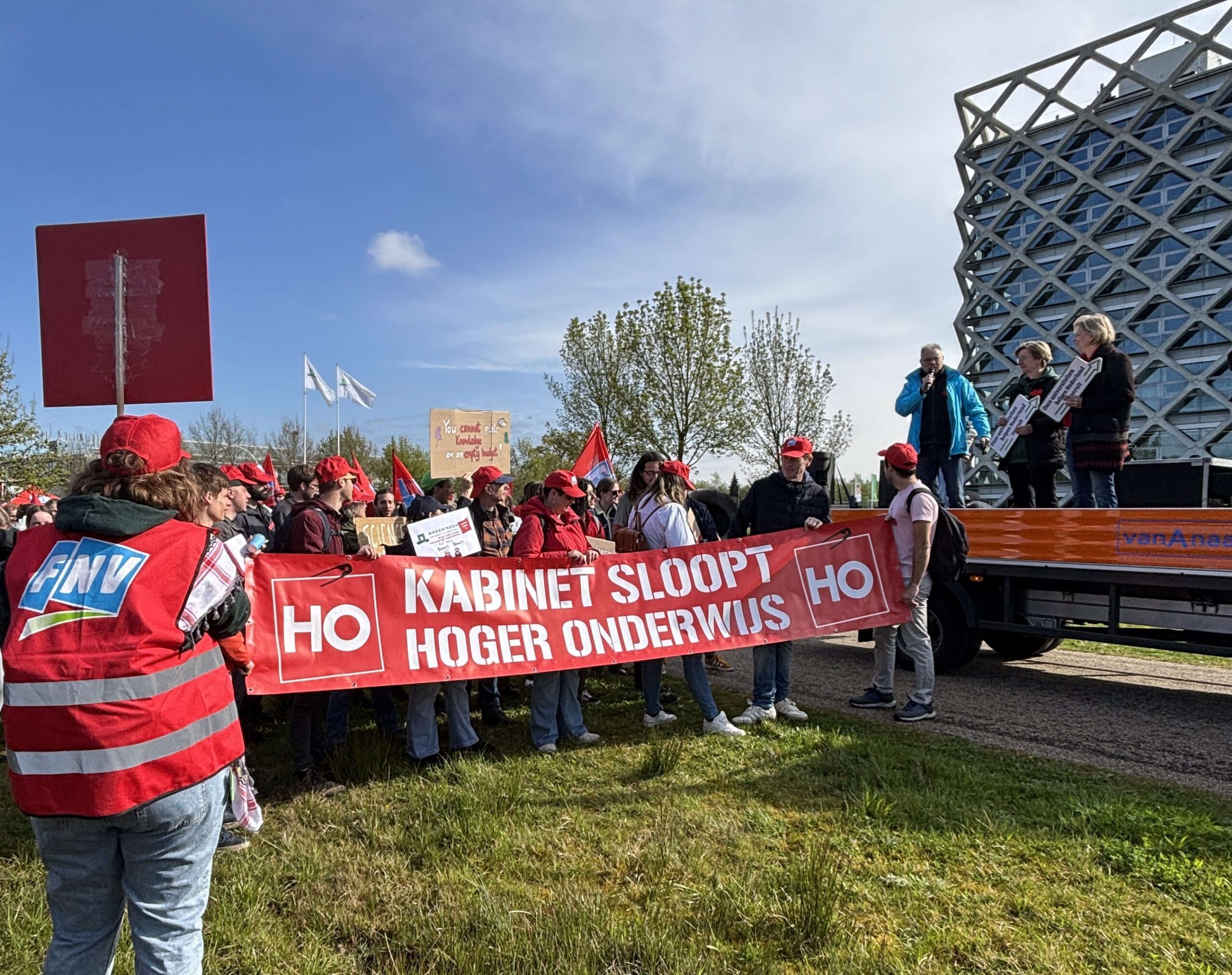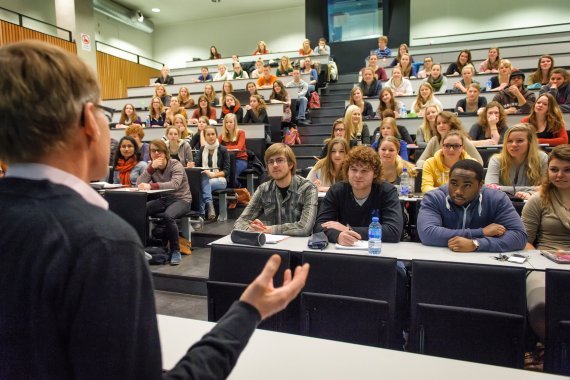Harsh winters seem to be a thing of the past, and yet the trees growing on Dutch soil benefit from the winter cold. It is good for the seeds, blooms and buds. Will we still be rambling through the same woods in 30 years’ time? Resource takes a walk through the woods of the future.
It’s a Monday afternoon and about 7 degrees centigrade. We are standing beneath a dull grey sky in the woods at Oostereng, tall Douglas firs towering over us. ‘You can already see the future in the undergrowth,’ Louis König points out. Under the Douglas fir canopy grows the Christmas greenery of young shade-loving hemlock conifers in abundance. König and his colleague Bas Leerink are PhD students at Forest Ecology and Management, and Wageningen Environmental Research. Their research is on climate-smart forestry and the forest of the future.
It is a bit chilly in the forest, but is it really wintry? In view of the vanishingly small chance of the traditional Frisian Eleven Cities skating race this year, this month Dutch TV broadcast the last such race, in 1997. The lack of serious cold is a pity, and not just for the Frisians, but also for nature. Many trees need wintry spells to flower, and many seeds germinate better after a cold snap. What will be left of the forest now that the winters are getting milder and the summers are plagued by drought and heatwaves?
Rejuvenation
We walk past a plot where two old Scots pines stand out above a carpet of young pines and birches. König: ‘This is called a shelter wood system: you leave a couple of parent trees to reproduce. Natural rejuvenation is cheaper than planting, but it is less predictable.’ The system becomes more complex: with natural rejuvenation, germination and the survival of seeds are affected by the climate.
König is working on the EFISCEN Space model, which simulates the composition and growth of European forests in a range of different climate change and management scenarios. He bases his modelling on forest inventories across Europe. ‘Our current models define in advance what kind of forest will return after logging, or simply assume that the same forest will return. These assumptions rarely hold true.’ He points to a larch wood. ‘The old model would predict a new larch forest, but that is not correct: we are already seeing that the undergrowth consists of hemlock. I hope my approach will reflect those trends.’
Lerink applies the model to calculate how much carbon a forest can store and how much timber we can harvest in the future. ‘We want to move towards a bio-economy, by building wooden houses for example. But nobody knows how much wood is going to be available.’ Softwood from conifers has long fibres that are suitable for building. Deciduous wood is less suitable for that purpose.
Winter cold
Cold is an important factor in the reproduction of trees, says König. ‘We expect that climate change will influence flowering and seed production, but exactly how is a complex question and we don’t know the answer yet.
Trees can die of heatstroke
For most trees, winter cold is important for the spring blossom. Without that cold, flowering can be delayed or irregular, or there may be fewer flowers and seeds’. Winter cold and spring temperatures also play a role in seed dormancy and germination.
Meanwhile, we have kicked our way through a thick layer of leaves. The forest is more open here. An old beechwood surrounds us. ‘Trees have different strategies for building up a seed bank,’ says König. ‘The beech tree relies on a seed rain: every year it drops a new batch of seeds that germinate in the spring. Depending on the conditions, they go on growing or die off. In coniferous trees, the seeds remain stuck to the tree in cones, which the tree drops when the conditions are right. Climate change may influence these strategies differently, but it’s not clear how yet’.
Winners and losers
The beech wood looks robust enough, but beeches are vulnerable too. The greatest threat to European forests is drought, says König. Droughts are becoming longer and more severe, and there are more and more heatwaves. Trees can then die of heatstroke, especially in southern Europe: they evaporate too much water and just dry out. There has been massive die-back in beech woods in France, for example.’
The Norway spruce is particularly hard hit by climate change. Lerink: ‘The spruce produces less resin due to drought and heat and therefore has little defence against the European spruce bark beetle.’ This necessitates extensive tree-felling. ‘Almost three quarters of the German timber harvest can be put down to this beetle,’ adds König. As a result of climate change and changing management approaches, König expects conifers to retreat to colder climates and beech and oak to spread here.
Resilience
We can also give the forest a helping hand by planting drought-tolerant trees, Lerink suggests. ‘We call that assisted migration. But we are cautious about planting trees from the south: in the Netherlands you still get late frosts in March and April. That can affect the early flowering of southern trees.’
Natural rejuvenation also makes trees more resistant to drought than planting does, according to König. ‘Because the seeds germinate here, the seedlings are better rooted than transplanted ones are.’
Winter cold is important for the spring blossom
Also, rejuvenation leads to a transition from monoculture to mixed forest, with multiple layers. This helps make the forest more resilient to extreme weather. Despite the retreat of conifers to colder regions, König therefore believes that pine and spruce can continue to survive in mixed forests.
Creative with wood
The two forest ecologists look at the treetops, with their dark branches against the grey sky. Lerink loves the ‘mystique’ of the forest and enjoys working with wood: in his spare time, he makes furniture. ‘The bark beetle makes beautiful patterns in the wood of the Norway spruce, and I use that wood to make chairs.’ König’s hobby comes from his grandfather, a woodcutter, who used to take him into the forest when he was a child. ‘He encouraged me to go into forestry. It is the nicest profession: being out in nature, the fresh air and the peace. Trees are just wonderful.’

 Louis König and Bas Leerink, PhD students at Forest Ecology and Forest Management, are researching climate-smart forestry, the forest of the future. ‘We expect that climate change will influence flowering and seed production, but exactly how is a complex question.’ Photo: Guy Ackermans
Louis König and Bas Leerink, PhD students at Forest Ecology and Forest Management, are researching climate-smart forestry, the forest of the future. ‘We expect that climate change will influence flowering and seed production, but exactly how is a complex question.’ Photo: Guy Ackermans 

